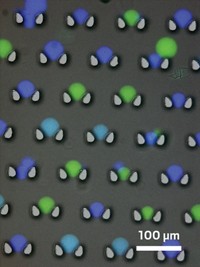Advertisement
Grab your lab coat. Let's get started
Welcome!
Welcome!
Create an account below to get 6 C&EN articles per month, receive newsletters and more - all free.
It seems this is your first time logging in online. Please enter the following information to continue.
As an ACS member you automatically get access to this site. All we need is few more details to create your reading experience.
Not you? Sign in with a different account.
Not you? Sign in with a different account.
ERROR 1
ERROR 1
ERROR 2
ERROR 2
ERROR 2
ERROR 2
ERROR 2
Password and Confirm password must match.
If you have an ACS member number, please enter it here so we can link this account to your membership. (optional)
ERROR 2
ACS values your privacy. By submitting your information, you are gaining access to C&EN and subscribing to our weekly newsletter. We use the information you provide to make your reading experience better, and we will never sell your data to third party members.
Synthesis
DNA Robots Detect Blood Cell Types
Combination of cell-surface markers triggers molecular cascade that results in a fluorescent signal
by Celia Henry Arnaud
August 5, 2013
| A version of this story appeared in
Volume 91, Issue 31
Different types of immune cells in the blood can be recognized for diagnostic and therapeutic purposes by the glycoprotein markers on their surface. For example, B cells typically express the markers CD45 and CD20, whereas T cells have CD45 and CD3. In a new recognition approach—developed by Sergei Rudchenko of the Hospital for Special Surgery in New York City, Milan N. Stojanovic of Columbia University, and coworkers—a set of molecular robots made of double-stranded DNA-antibody conjugates undergo molecular cascades when they bind to particular combinations of cell-surface markers (Nat. Nanotechnol. 2013, DOI: 10.1038/nnano.2013.142). After a combination of robots binds to a cell surface, adding the right single-stranded DNA molecule triggers a cascade of strand displacement reactions. Each reaction starts with an incoming strand binding to a short overhanging sequence and replacing the existing strand to form a new pair of oligonucleotides with a longer complementary sequence than the previous pair. The last reaction in the cascade unveils a molecular label that gives off a fluorescent signal, which is revealed only if the cascade runs to completion. The researchers used the DNA robots to identify groups of cells that express particular combinations of two or three cell markers.





Join the conversation
Contact the reporter
Submit a Letter to the Editor for publication
Engage with us on Twitter